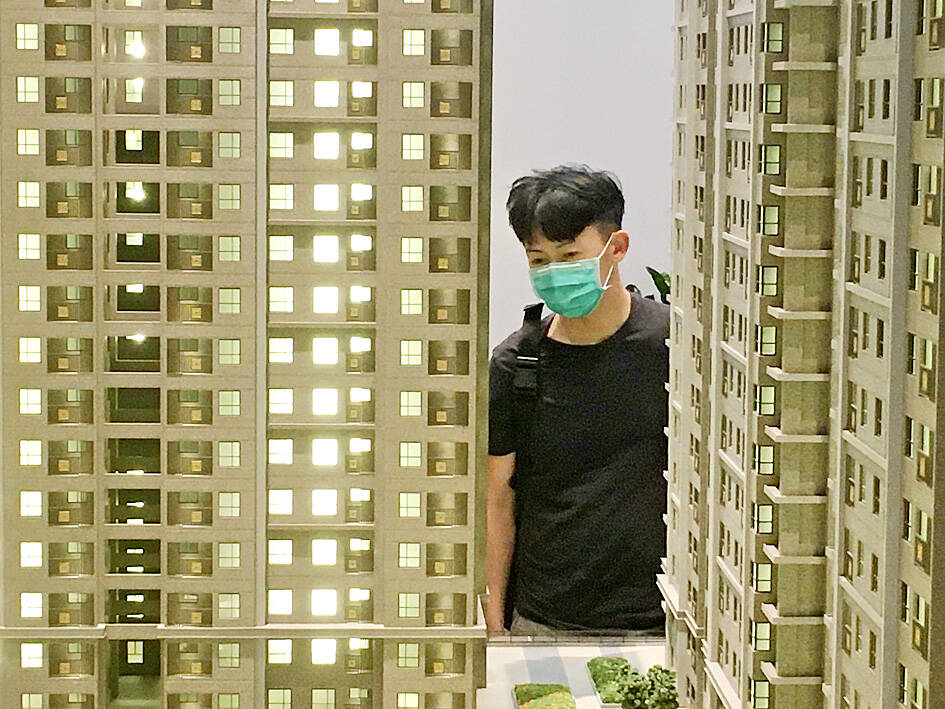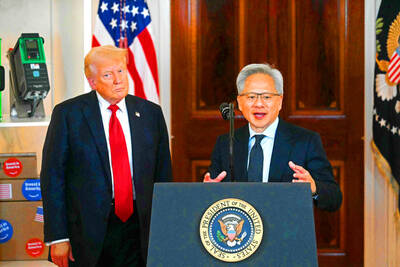Taiwan’s housing price index grew 1.82 percent to 133.18 in the third quarter of last year, when mortgage burdens picked up 0.16 percent from the second quarter to 42.25 percent of average household income, indicating that housing unaffordability sharpened, Ministry of the Interior data showed yesterday.
The reading represented a 5.42 percent hike compared with a year earlier, although the pace eased slightly for five consecutive quarters, the ministry found.
Overall, the house price-to-income ratio climbed to 9.82 times the average of household income nationwide, also a new high.

Photo: Hsu Yi-ping, Taipei Times
The trend ran counter to joint efforts by policymakers to facilitate a soft landing for house prices, as housing unaffordability has long topped the public’s complaint, especially among young people.
Solid real demand and building material price hikes lent support to home prices, Sinyi Realty Inc (信義房屋) research manager Tseng Ching-der (曾敬德) said.
The government’s introduction in August last year of interest rate subsidies for first-home purchases put an end to a year-long slowdown caused by unfavorable measures and monetary tightening, Tseng said.
Meanwhile, housing transactions totaled 79,812 units nationwide from July to September, rising 6.91 percent from three months earlier and 9.14 percent from a year earlier, affirming a recovery, the ministry’s Web site showed.
The mortgage burden was highest at 67.13 percent in Taipei, where house prices spiked to 15.67 times household income, it showed.
The mortgage burden in New Taipei City stood at 55.35 percent, after house prices increased to 12.92 times household income, the ministry said.
The government deems mortgage burdens of 30 percent as reasonable, 30 to 40 percent as relatively high, and more than 50 percent as overly high.
Affordability in Taichung joined the “ultra-low” category as house prices constituted 11.74 times household income and the mortgage burden grew to 50.32 percent, it said.
Developers have in recent years introduced new luxury apartment complexes in Taichung to take advantage of its metro system and other improving infrastructure facilities.
Affordability in Tainan and Kaohsiung was relatively low, with mortgage burdens standing at 40.67 percent and 39.74 percent respectively after house prices climbed to 9.49 times and 9.27 times household income, the ministry said.
Mortgage burdens were also high in Taoyuan, Hsinchu, Miaoli, Changhua, Nantou, Yunlin, Taitung, Hualien and Yilan, in addition to the outlying counties of Penghu and Kinmen, it said.
By contrast, affordability was reasonable in Keelung, as well as in Pingtung and Chiayi counties, it said.
Supply and demand would dominate the housing market’s direction after political uncertainty linked to the presidential election settled, Sinyi said.

Taiwan Semiconductor Manufacturing Co (TSMC, 台積電) last week recorded an increase in the number of shareholders to the highest in almost eight months, despite its share price falling 3.38 percent from the previous week, Taiwan Stock Exchange data released on Saturday showed. As of Friday, TSMC had 1.88 million shareholders, the most since the week of April 25 and an increase of 31,870 from the previous week, the data showed. The number of shareholders jumped despite a drop of NT$50 (US$1.59), or 3.38 percent, in TSMC’s share price from a week earlier to NT$1,430, as investors took profits from their earlier gains

AI TALENT: No financial details were released about the deal, in which top Groq executives, including its CEO, would join Nvidia to help advance the technology Nvidia Corp has agreed to a licensing deal with artificial intelligence (AI) start-up Groq, furthering its investments in companies connected to the AI boom and gaining the right to add a new type of technology to its products. The world’s largest publicly traded company has paid for the right to use Groq’s technology and is to integrate its chip design into future products. Some of the start-up’s executives are leaving to join Nvidia to help with that effort, the companies said. Groq would continue as an independent company with a new chief executive, it said on Wednesday in a post on its Web

CHINA RIVAL: The chips are positioned to compete with Nvidia’s Hopper and Blackwell products and would enable clusters connecting more than 100,000 chips Moore Threads Technology Co (摩爾線程) introduced a new generation of chips aimed at reducing artificial intelligence (AI) developers’ dependence on Nvidia Corp’s hardware, just weeks after pulling off one of the most successful Chinese initial public offerings (IPOs) in years. “These products will significantly enhance world-class computing speed and capabilities that all developers aspire to,” Moore Threads CEO Zhang Jianzhong (張建中), a former Nvidia executive, said on Saturday at a company event in Beijing. “We hope they can meet the needs of more developers in China so that you no longer need to wait for advanced foreign products.” Chinese chipmakers are in

POLICY REVERSAL: The decision to allow sales of Nvidia’s H200 chips to China came after years of tightening controls and has drawn objections among some Republicans US House Republicans are calling for arms-sale-style congressional oversight of artificial intelligence (AI) chip exports as US President Donald Trump’s administration moves to approve licenses for Nvidia Corp to ship its H200 processor to China. US Representative Brian Mast, the Republican chairman of the US House Committee on Foreign Affairs, which oversees export controls, on Friday introduced a bill dubbed the AI Overwatch Act that would require the US Congress to be notified of AI chips sales to adversaries. Any processors equal to or higher in capabilities than Nvidia’s H20 would be subject to oversight, the draft bill says. Lawmakers would have